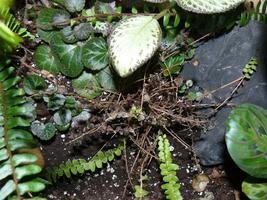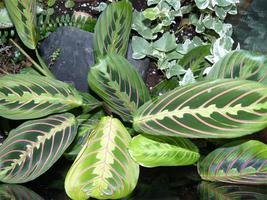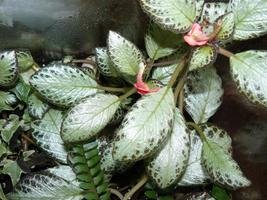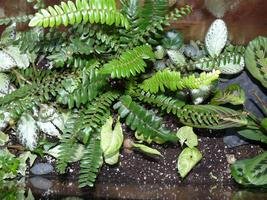





Hopefully after reading my past 2 articles on terrariums, you are all hooked for life and have started your own mini jungle in the house. Now that it has been a month or so, there are a few things we need to do to keep your terrariums happy and healthy.
For those of you who missed those two articles, they were "Aquarium to Terrarium" and "Terrariums, Anything Goes". Click on the title to be taken directly to the article.
 The first thing I do is take some paper towels and window cleaner and wipe off the assorted nose prints the critters have deposited on the outside surfaces. Occasionally, I will also take a cloth and wipe down any extra condensation on the inside. This depends entirely on how much condensation the terrarium is producing. Remember, the condensation is a good thing, up to a point. Too much of it for too long and you will notice rotting/mildewy leaves on some of your plants. Condensation can be controlled by cracking the lid a bit, but once in a while it gets a tad rainy in there, depending on my house conditions. Cold North window with radiator pipes running under the table, condensation galore.
The first thing I do is take some paper towels and window cleaner and wipe off the assorted nose prints the critters have deposited on the outside surfaces. Occasionally, I will also take a cloth and wipe down any extra condensation on the inside. This depends entirely on how much condensation the terrarium is producing. Remember, the condensation is a good thing, up to a point. Too much of it for too long and you will notice rotting/mildewy leaves on some of your plants. Condensation can be controlled by cracking the lid a bit, but once in a while it gets a tad rainy in there, depending on my house conditions. Cold North window with radiator pipes running under the table, condensation galore.
The next thing we need to do is take the lid off and inspect the plants for any dead or rotting leaves. These need to be removed. If they are left the rot will spread to other, healthy leaves. Don't fret if you see a few rotted leaves, it happens, just like it would in a real jungle. In the photo at the right you can see a fern that didn't make it. I left it there for the purpose of this article. We need to remove it. This is easily done since the root system is not very deep. Just give it a tug or dig it out with a teaspoon. The fern was an iffy prospect to begin with, found on the .50 cent rack in a local box store, I put it there just as an experiment. Terrariums are all about experimentation. I will replace it with an Episcia Lilacina that is struggling with my dry, indoor conditions. Hopefully, the warm, humid terrarium atmosphere will be to its liking.
These need to be removed. If they are left the rot will spread to other, healthy leaves. Don't fret if you see a few rotted leaves, it happens, just like it would in a real jungle. In the photo at the right you can see a fern that didn't make it. I left it there for the purpose of this article. We need to remove it. This is easily done since the root system is not very deep. Just give it a tug or dig it out with a teaspoon. The fern was an iffy prospect to begin with, found on the .50 cent rack in a local box store, I put it there just as an experiment. Terrariums are all about experimentation. I will replace it with an Episcia Lilacina that is struggling with my dry, indoor conditions. Hopefully, the warm, humid terrarium atmosphere will be to its liking.
 The next thing we'll do is take a plain old dessert fork and ruffle up the soil a bit. This helps all of that nice moisture dripping down the sides find its way to the roots. I'll also use this opportunity to "rake" in a bit more of the activated charcoal. The charcoal helps keep the soil fresh smelling. This isn't really neccessary but since I have fish, I have used charcoal and don't like to just throw it out. I have never noticed anything other than a sweet, earthy, "right after it rains" scent in my terrarium.
The next thing we'll do is take a plain old dessert fork and ruffle up the soil a bit. This helps all of that nice moisture dripping down the sides find its way to the roots. I'll also use this opportunity to "rake" in a bit more of the activated charcoal. The charcoal helps keep the soil fresh smelling. This isn't really neccessary but since I have fish, I have used charcoal and don't like to just throw it out. I have never noticed anything other than a sweet, earthy, "right after it rains" scent in my terrarium.
Since we have the lid off, now is a good time to do any adding or rearranging of plants. I have decided I need something else variegated in there so will also add a Syngonium. A terrarium is just like your garden outside, it is never really finished, it grows and changes. Speaking of growing, any plants that have out-grown the environment should be thinned. I have an unknown Episcia that is getting close, but since it's well behaved, and starting to bloom, I have decided to leave it for now.
Syngonium. A terrarium is just like your garden outside, it is never really finished, it grows and changes. Speaking of growing, any plants that have out-grown the environment should be thinned. I have an unknown Episcia that is getting close, but since it's well behaved, and starting to bloom, I have decided to leave it for now.
This 35 gallon terrarium in the photos has not needed to be watered for about 3 months now. It is completely self-sufficient. I keep it in a North facing window and have a light on it to help lengthen our short, winter days. Later in the summer, when the sun starts to peek through that window, I will have to keep the curtains closed so it stays bright but shady. Sunshine is an enemy of the terrarium, plants can easily  be cooked since the glass magnifies the suns rays. I also spin the terrarium around once a week to keep the plants growing evenly.
be cooked since the glass magnifies the suns rays. I also spin the terrarium around once a week to keep the plants growing evenly.
There you have it. One clean, tidy terrarium. That was easy, wasn't it? Took me roughly 30 minutes. I do this once every couple of months. Now that you know how easy it is to maintain a terrarium, I hope more of you will consider adding one to your indoor garden. Enjoy!!
All of the photos in this article are my own.
Copyright © www.100flowers.win Botanic Garden All Rights Reserved